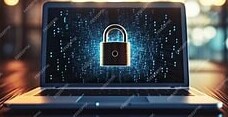In our hyper-connected world, keeping our digital lives secure is more critical than ever. Laptops are not just work tools; they’re gateways to personal and professional information that cybercriminals are eager to access. Understanding the basics of laptop security and privacy can help prevent unauthorized access and data breaches.
 Think of your laptop like the safe in your house. Just as you wouldn’t leave the safe open with valuables exposed, neither should you leave your digital doors unguarded. Often, the risks aren’t just from hackers deploying complex attacks but from carelessness or lack of awareness about potential threats.
Think of your laptop like the safe in your house. Just as you wouldn’t leave the safe open with valuables exposed, neither should you leave your digital doors unguarded. Often, the risks aren’t just from hackers deploying complex attacks but from carelessness or lack of awareness about potential threats.
Why is privacy such a big deal on laptops these days? It’s simple—most of our lives unfold online. Everything from banking details to private correspondence often ends up stored on digital devices. Failing to protect this information can lead to identity theft, financial loss, or exposure of sensitive data.
With work increasingly shifting online, especially in remote setups, safeguards need to address both the technology and the human factors involved. An educated and aware user is often the first line of defense against potential security breaches. Securing your laptop involves understanding the vulnerabilities that exist, recognizing them, and taking proactive measures to mitigate risks.
Top Laptop Security Tips for Everyone
Keeping your laptop secure isn’t just a matter for IT wizards; it’s something anyone can handle with the right approach. One of the easiest steps to bolster your laptop’s security is to install reliable antivirus software. This software acts like a digital bodyguard, screening for malicious attacks and keeping your data safe.
Passwords are another line of defense, but not all passwords are created equal. Use strong, unique passwords that blend numbers, symbols, and letters. Using a password manager can simplify things by securely storing your complex passwords and even generating them for you.
Multi-factor authentication (MFA) adds another layer of protection. It’s like having two locks on your door. Even if a thief manages to pick one, they’ll struggle with the other unless they have that second key—a verification code usually sent to your phone or email.
Keeping your software up to date might seem annoying with all those pop-up reminders, but those updates often patch security vulnerabilities. Staying current with updates can make all the difference in avoiding potential exploits.
Remember, security begins with being informed and proactive. Taking these steps doesn’t just protect your laptop; it protects your digital life from becoming easy prey for cyber threats.
Safeguarding Remote Workers: Essential Security Practices
Remote work has transformed how we approach office security, and new challenges have emerged. Knowing the unique risks faced by remote employees is a must for anyone working outside traditional office walls.
Establishing clear security protocols is vital. Companies should provide guidelines on data handling, including how to secure and transport sensitive information. Having these outlined instructions helps employees stay on track even when they’re not physically present in an office.
It’s not just about rules. Equip your team with the right tools. For instance, secure communication apps ensure discussions stay private, while encrypted storage solutions can safeguard files from prying eyes. Ensuring everyone has access to these tools is part and parcel of an effective security strategy.
Being aware of the surrounding environment when working remotely is just as critical. Encourage remote employees to situate themselves in a quiet, private space when handling sensitive info. Overheard conversations could easily lead to unintended data leaks.
A culture that emphasizes ongoing training and awareness helps keep security top of mind. Regular sessions on emerging threats and best practices ensure everyone knows what to look out for and how to respond swiftly, minimizing risks and maintaining a strong defense against potential breaches.
Ensuring Your Laptop’s Safety While Working Remotely
On-the-go work presents a host of security challenges, but it doesn’t have to mean exposing your data to unnecessary risk. One of the first priorities should be making sure your Wi-Fi connection is secure, especially if you’re working from public areas. Always opt for a password-protected network and avoid using open Wi-Fi connections whenever possible.
A Virtual Private Network (VPN) is your best friend here. It encrypts your internet traffic, making it far more difficult for outsiders to see what you’re doing online. This is crucial for maintaining the integrity of your work and personal data when you’re out and about.
When it comes to data, keeping files encrypted on a Windows based platform or a MAC based platform is a smart move. Encryption ensures that even if someone manages to intercept your data, it remains unreadable without the proper decryption key. This adds a significant hurdle for anyone trying to gain unauthorized access.
Sharing documents over online platforms is practically unavoidable, so using secure file-sharing services is a must. Only use services that provide encrypted transfers to keep your documents safe from interception.
Being mindful of your physical surroundings is another essential habit. Choose spots away from prying eyes and ensure your screen isn’t visible to others. This prevents visual hacking where someone might glean sensitive information just by looking over your shoulder.
Work-from-Home Security Strategies
Securing your home network is a crucial starting point for any work-from-home security plan. This involves setting a strong password for your Wi-Fi and ensuring your router firmware is up to date to guard against any known vulnerabilities. A strong Wi-Fi password should:
- Be at least 12 characters long.
- Include a mixture of letters, numbers, and symbols.
- Be unique and not include your username or personal details.
Handling sensitive company data and documents requires extra care. It’s wise to store work files separately from personal ones, ideally on a secure cloud storage platform with robust security settings.
Developing basic cybersecurity habits is something every remote worker should take seriously. Simple practices like logging out of accounts when not in use and shutting down your laptop rather than just closing it or putting it into “sleep mode” can make a world of difference. Implementing regular checks of network permissions also prevents unauthorized access.
Setting up a dedicated, secure space for work helps maintain both focus and security. This area should be free of distractions and offer privacy to reduce the risk of unintentional data exposure. Knowing who can access your workspace can help manage potential security risks.
Remember, turning off unnecessary devices connected to your network can reduce potential entry points for hackers. The fewer devices connected, the fewer opportunities for exposure, aiding in maintaining a secure work environment.
Protecting Laptops in Remote Work Scenarios
Data breaches can be devastating, especially in remote work setups where multiple devices and connections are in use. To reduce this risk, it’s essential to establish a habit of regularly reviewing your digital footprint. This means keeping an eye on what apps have permissions and what data they have access to.
Managing access permissions effectively involves more than just setting passwords. Regular checks and updates to permissions can prevent old accounts or outdated software from becoming potential weak points. Ensuring that only necessary apps and users have access can significantly lower the risk profile of your laptop and data.
Phishing scams and social engineering attacks are on the rise, often targeting remote workers through seemingly innocuous communications. Being skeptical of unsolicited emails, double-checking the sources, and not clicking on links from unknown senders are pivotal in safeguarding against these attacks.
It’s also prudent to use secure connections for everything from Zoom meetings to email exchanges. Make sure any platform you use comes with up-to-date security features and encourages you to apply these tools effectively.
Never underestimate the power of awareness. Continuously educating yourself and your team about potential security threats and defense strategies helps cultivate a proactive rather than reactive approach to digital safety.
Best Practices in Laptop Security for Remote Professionals
Laptop safety extends beyond the virtual; physical security measures are just as important. Using privacy screens can deter prying eyes when you’re working in public places, safeguarding your sensitive information from opportunistic onlookers.
Regular and secure data backups are a must—think of them as your security net. Whether using cloud-based solutions or external hard drives, ensuring that copies of your crucial documents exist in multiple secure locations can save you in the event of data loss.
Physical theft of laptops poses a significant risk, especially for those who travel for work. Keeping your device in a secure bag and never leaving it unattended helps minimize this risk. Also, tracking software can be an invaluable tool, allowing you to locate your laptop if it goes missing.
Many professionals overlook the importance of a clean and organized digital workspace. Regularly decluttering your files and removing unnecessary or outdated software reduces potential vulnerabilities and keeps your system running smoothly.
Security isn’t a set it and forget it task. It’s essential to perform regular audits of your security practices, updating them as needed to adapt to new threats or changes in your work environment. This proactive approach ensures that you’re always a step ahead of potential security incidents.
Boosting Cybersecurity for Remote Workers
Cybersecurity awareness among remote workers is crucial as it serves as the first line of defense against cyber threats. Regular training sessions can empower employees by teaching them to identify various scams and potential security breaches.
Building a solid cybersecurity strategy begins with having a plan that addresses specific vulnerabilities related to remote work. This includes using up-to-date software solutions and tools designed to protect data and enhance communication security.
Maintaining open channels of communication about cybersecurity within remote teams fosters a collaborative environment where everyone is committed to maintaining security standards. Regular check-ins on security status keep everyone aligned and informed about the latest threats.
Education doesn’t stop at basic awareness. Encouraging ongoing learning about new security techniques and trends ensures that remote workers are well-equipped to handle evolving threats. Resources like webinars, online courses, and security bulletins can be invaluable for staying updated.
It’s essential that comprehensive policies are not only established but also consistently reinforced. Ensuring that everyone knows and understands these policies makes it easier to secure sensitive information across various devices and networks used by remote workers.
The Ultimate Steps to Protect Laptops from Cyber Threats
Securing laptops against cyber threats requires a comprehensive strategy that combines multiple layers of security measures. Organizing these measures into a cohesive plan helps in effectively safeguarding your devices.
Regular audits of your security protocols are essential. These audits facilitate the identification of any weaknesses in your current setup and allow you to address them promptly. Keeping track of potential vulnerabilities ensures your security measures remain robust and reliable.
Besides audits, anticipating future threats by staying informed about the latest trends in cybersecurity can prove beneficial. This proactive approach involves subscribing to credible cybersecurity updates and using them to adjust your strategies accordingly.
Consider leveraging advanced tools like AI-driven security software for threat detection and response. These innovative solutions can offer unparalleled protection against sophisticated cyber attacks, strengthening your overall defense.
Finally, creating a culture of vigilance around cybersecurity reinforces its importance among all users involved. Encouraging open discussions about experiences with cyber threats and sharing practical tips help everyone stay prepared and attentive to potential risks.

Very informative article. In this day and age you can never be too careful. I got scammed on a site that was supposed to be a help site. It had microsoft in so I thought it was safe. After determining that it was a hacker site I quickly shut down. You can never be too careful. I think the issues that you brought up will resonate with all users.